What is Google Adwords?
Google Adwords, now called Google Ads, is a platform for creating advertisements for display on Google-owned platforms, services, and third-party partner sites.
Ads set up through Google Ads are displayed at several locations, including the Google Search results pages, YouTube, Google Shopping, Google Maps, and third-party sites and apps through Google Display Network.
Google Ads operates on a pay-per-click (PPC) model, wherein advertisers bid on specific keywords relevant to their products or services. These bids include the maximum amount the advertiser wants to pay to have their ad appear when visitors search for their target keywords.
Google then multiplies the advertiser’s maximum bid with their quality score to reach an ad rank. The advertiser with the highest ad rank gets the top ad position for the target keyword.
Importance of Google Ads
Google ads provide advertisers with several benefits. We will now address some of them below.
1 Increased Online Visibility
Google Ads allow businesses to reach a wider web audience. This increases online visibility, leading to more brand recognition, traffic, and potential customers for the business.
2 Targeted Advertising
Google Ads allow advertisers to target their audience based on various criteria, including the keywords the audience searched for, the device they use, their location, and their age demographic.
3 Pay-per-Click Advertising
Google Ads operate on a pay-per-click (PPC) model, wherein advertisers only pay for actual clicks received. This is more relevant than other cost models like pay-per-impression (PPI) and cost-per-thousand-impressions (CPM), which charge based on the views the ad receives.
4 Measurable Results and Tracking
Google Ads provide comprehensive tracking and reporting tools that allow businesses to measure the performance of their ads. These tools provide valuable insights into the effectiveness of the ad campaigns, allowing for optimization and improvement.
5 Quick and Immediate Results
Google Ads can drive targeted traffic to a website almost instantly. This is especially beneficial for businesses looking for immediate results or time-sensitive promotions. It is also quicker than search engine optimization (SEO) campaigns, which take time to yield results.
Definition of Some Key Terms in Google Ads
Advertisers will encounter some technical terms while running their Google Ads campaign. They may encounter the terms on the Google Ads dashboard or as part of their broader ad campaign. Some of these terms include:
- Mots clés
- Quality score
- Ad rank
- Cost per click (CPC)
- Click-through rate (CTR)
- Ad extensions
- Ad groups
It is crucial to understand the definition of these terms to get the most out of your ads. So, we will now provide more insights into them below.
1 Mots clés
Keywords refer to the words or phrases advertisers target in their ad campaigns. These keywords are relevant to the products, services, or content the advertiser wants to promote.
When a visitor searches for those keywords on Google, the advertiser’s ads may appear on the search results page along with the organic results Google returns for searches.
Google Ads provide various keyword match types that advertisers can use to control how closely a user’s search query must match their chosen keywords for their ad to appear. The match types available in Google Ads include:
- Broad match
- Modified broad match
- Phrase match
- Exact match
- Negative match
Broad Match — The broad keyword match type indicates that the ads may be triggered by related searches and variations of the keyword, including synonyms, misspellings, or related terms.
Modified Broad Match — The modified broad keyword match type allows advertisers to specify the keywords or keyword variations that must be present in the user’s search query for their ad to be triggered.
Phrase Match — The phrase keyword match type indicates the ads are to be shown when the user’s search query includes the specific keyword phrase or close variations.
Correspondance exacte — The exact keyword match type indicates that the ad should be displayed only when the user’s search query precisely matches the specified keyword.
Negative Match — The negative keyword match type lists the keywords or terms for which the ad must not be displayed.
2 Quality Score
Quality Score is a metric used to evaluate the quality and relevance of a keyword, ad, and landing page. It plays a significant role in determining the ad rank and cost per click (CPC) for a given keyword.
The Quality Score is assigned to each keyword in an Ads account and is measured on a scale of 1 to 10, with 10 being the highest score and zero being the lowest.
Google does not disclose the exact formula it uses to calculate the Quality Score. However, it is based on multiple factors, including:
- Ad relevance
- Click-through rate
- Landing page experience
Ad Relevance — The ad relevance is the extent to which the ad text aligns with the searched keyword and user intent. Ads that closely match the keyword are considered more relevant.
Click-Through Rate (CTR) — The click-through rate is the proportion of users who click on the ad compared to those who saw the ad but did not click. It is used to estimate the performance of the keyword and ad.
Landing Page Experience — The landing page experience indicates the quality and relevance of the landing page visitors arrive at after clicking an ad. A well-designed, user-friendly, and informative landing page improves the landing page experience.
Google evaluates these factors and then assigns the page a Quality Score. A higher Quality Score can lead to benefits like higher ad rank and lower CPC.
3 Ad Rank
Ad Rank is the metric Google uses to determine an ad’s position on the search engine results page (SERP). The ad with the highest ad rank will typically appear in the top position on the search engine results page.
The ad rank is calculated by multiplying a keyword’s quality score by the advertiser’s maximum bid amount.

4 Cost Per Click (CPC)
Cost per Click (CPC) refers to the amount an advertiser pays each time a user clicks on their ad.
Google Ads uses an auction system to determine the cost per click for an ad. When a visitor enters a search query that triggers ads, Google runs an auction to determine which ads will be shown and in what order.
Advertisers participating in the auction specify the maximum amount (called the maximum bid) they are willing to pay for a click on their ad.
However, the actual cost per click paid by the advertiser is typically lower than the maximum bid and is determined by several factors, including the advertiser’s ad rank and the maximum bid set by other advertisers competing for the same ad placement.
Cost per click is an important metric for advertisers as it directly impacts the cost and efficiency of their advertising campaigns. Advertisers can improve their cost per click by adjusting their maximum bids and improving their Quality Score.
5 Click-Through Rate (CTR)
Click-through rate (CTR) in Google Adwords is a metric that measures the percentage of users who click on an ad after it is displayed. It is calculated by dividing the number of clicks an ad receives by the number of impressions (or views) it generates and multiplying it by 100.
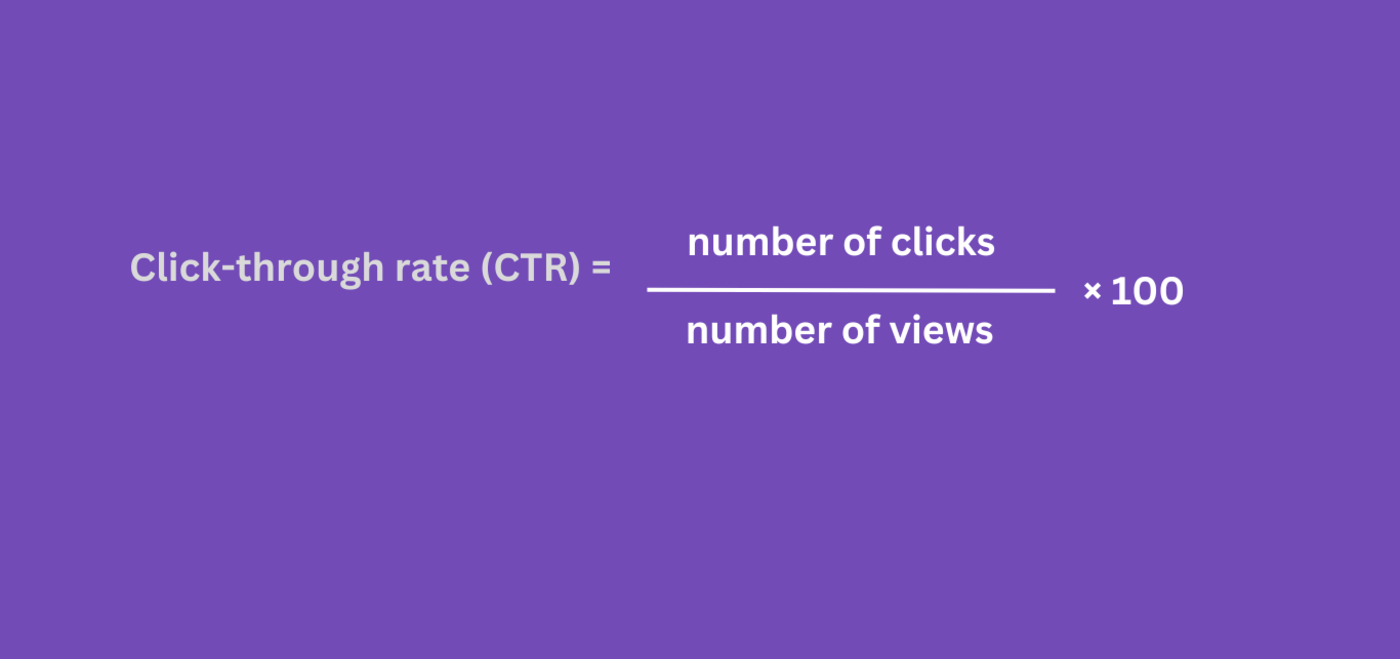
CTR provides insights into the ad’s effectiveness and relevance. A higher click-through rate indicates that the ad is relevant to the viewers. Similarly, a low click-through rate indicates the ad is irrelevant to the audience.
Google considers the click-through rate an essential factor in determining the Quality Score and ad rank for a keyword. Ads with higher CTRs are often rewarded with better ad positions and lower costs per click (CPC).
6 Ad Extensions
Ad extensions are additional information that can be added to an ad to provide more context, enhance visibility, and encourage users to take specific actions. They allow advertisers to expand their ads beyond the traditional headline, description, and URL.
Google Ads provides various ad extensions for different purposes. Some common ad extensions include:
- Sitelink extensions
- Call extensions
- Location extensions
- Callout extensions
- Review extensions
Sitelink Extensions — Site extensions allow advertisers to add additional links to their ads. These links direct visitors to specific pages on the advertiser’s site. Advertisers use sitelink extensions to promote specific products, highlight popular categories, and provide more options for users to explore.
Call Extensions — Call extensions allow advertisers to display their phone numbers on their ads. This makes it easier for ad viewers to call the business directly from the search results. Call extensions are helpful for businesses that rely on phone calls for conversions or inquiries.
Location Extensions — Local extensions display a business’s address alongside the ad. This makes it easier for users to find and visit a specific location. Location extensions are beneficial for businesses with physical storefronts or multiple branches.
Callout Extensions — Callout extensions allow advertisers to add short, additional snippets of text to highlight specific features or offers. They showcase free shipping, 24/7 customer support, price matching, and other unique selling points.
Review Extensions — Review extensions allow advertisers to display reviews and testimonials alongside their ads. The reviews are from reputable third-party sources and help build trust and credibility with potential customers.
7 Ad Groups
Ad groups are ads that share a common theme or target a group of keywords. They help advertisers group related ads and organize campaigns for improved management and optimization.
When setting up a Google Ads campaign, advertisers typically create multiple ad groups based on different product categories, target audience segments, or campaign objectives. Individual ads within the ad group are typically variations of the same message.
Types of Google Ads
Google Ads allows advertisers to set up various types of campaigns. The specific campaign type the advertiser selects determines the services and platforms on which the ads will be displayed or the method through which the ad will be set up.
Some ad types available in Google Ads include:
- Search ads
- Display ads
- Video ads
- Shopping ads
- App Promotion ads
- Discovery ads
- Smart ads
- Performance Max ads
1 Search Ads
Search ads appear on the Google search results page (SERP). They typically contain a headline, description, and URL and are labeled “Ad” or “Sponsored” to differentiate them from organic search results.
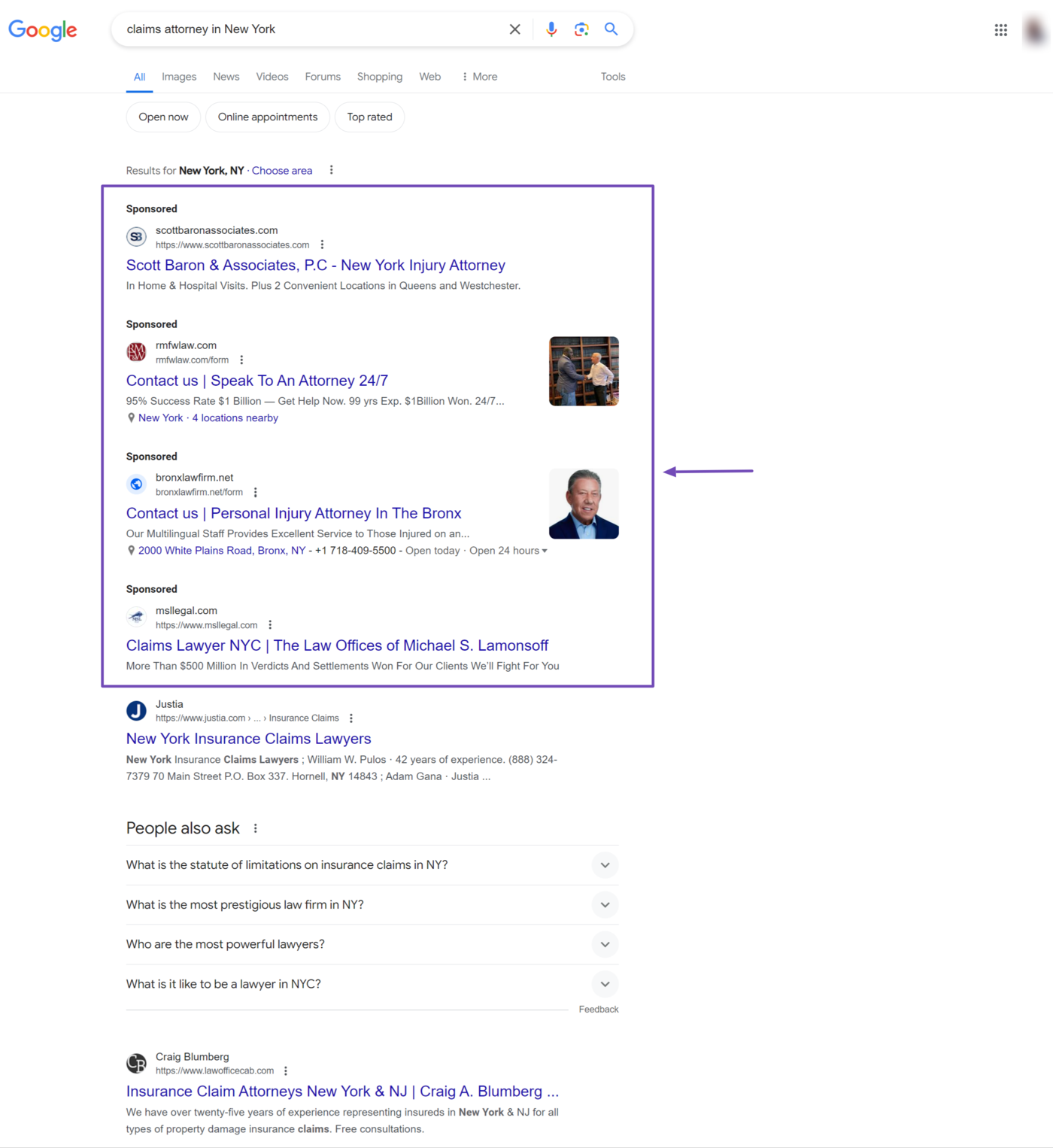
Search ads are designed to be highly targeted and relevant to the visitor’s search intent. This allows the advertiser to promote their offer to potential customers who are actively searching for information.
2 Display Ads
Display ads appear on third-party sites that have opted to display Google ads to their visitors. They are matched to relevant sites, content, and audiences based on criteria set by the advertiser.
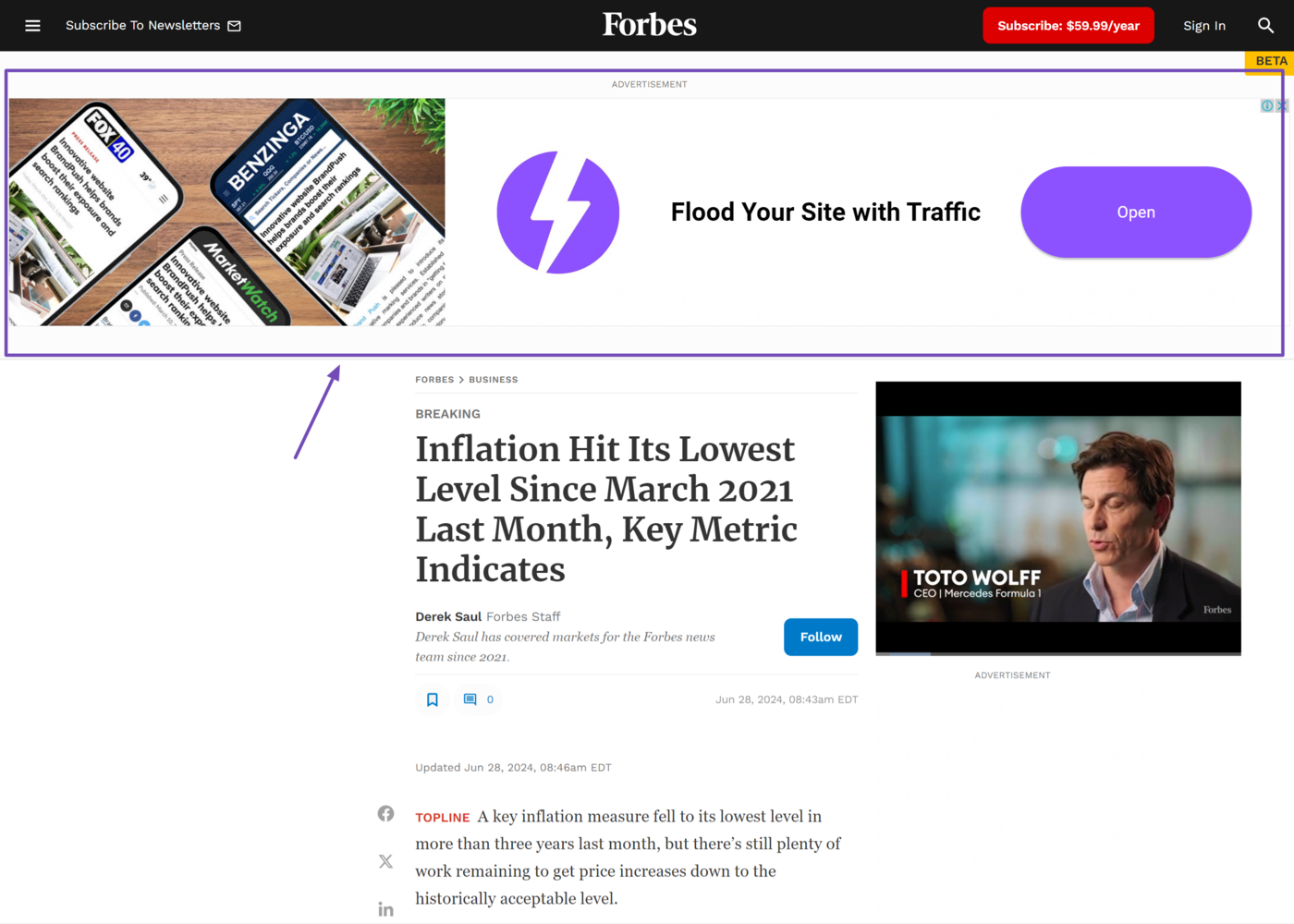
Display ads typically combine images, text, and sometimes interactive elements. They can also appear in various formats, including banner ads, rich media ads, and text ads.
Display ads can be an effective way for businesses looking to increase brand awareness, reach a broader audience, and drive traffic to their site or landing page.
3 Video Ads
Video ads allow advertisers to promote their products or services through video content. These ads are displayed on various platforms, including YouTube and the Google Display Network.
Advertisers can create video ads in different formats, such as:
- Skippable in-stream ads
- Non-skippable in-stream ads
- Bumper ads
- Out-stream ads
- Video discovery ads
Skippable in-stream ads — These are video ads that appear before, during, or after a YouTube video. Viewers have the option to skip these ads after five seconds.
Non-skippable in-stream ads — These are video ads that viewers must watch without the option to skip. They have short durations, typically no more than 15 seconds.
Bumper ads — These are short video ads that play before the main video. They cannot be skipped and are no longer than six seconds.
Out-stream ads — These are video ads displayed on third-party partner sites and apps within the Google Display Network. They are not shown on YouTube.

Video discovery ads —These ads appear alongside the YouTube search results. They could appear on the YouTube homepage or in the “Related Videos” section. Video discovery ads are displayed as thumbnail images and text. They lead viewers to the advertiser’s video when clicked.
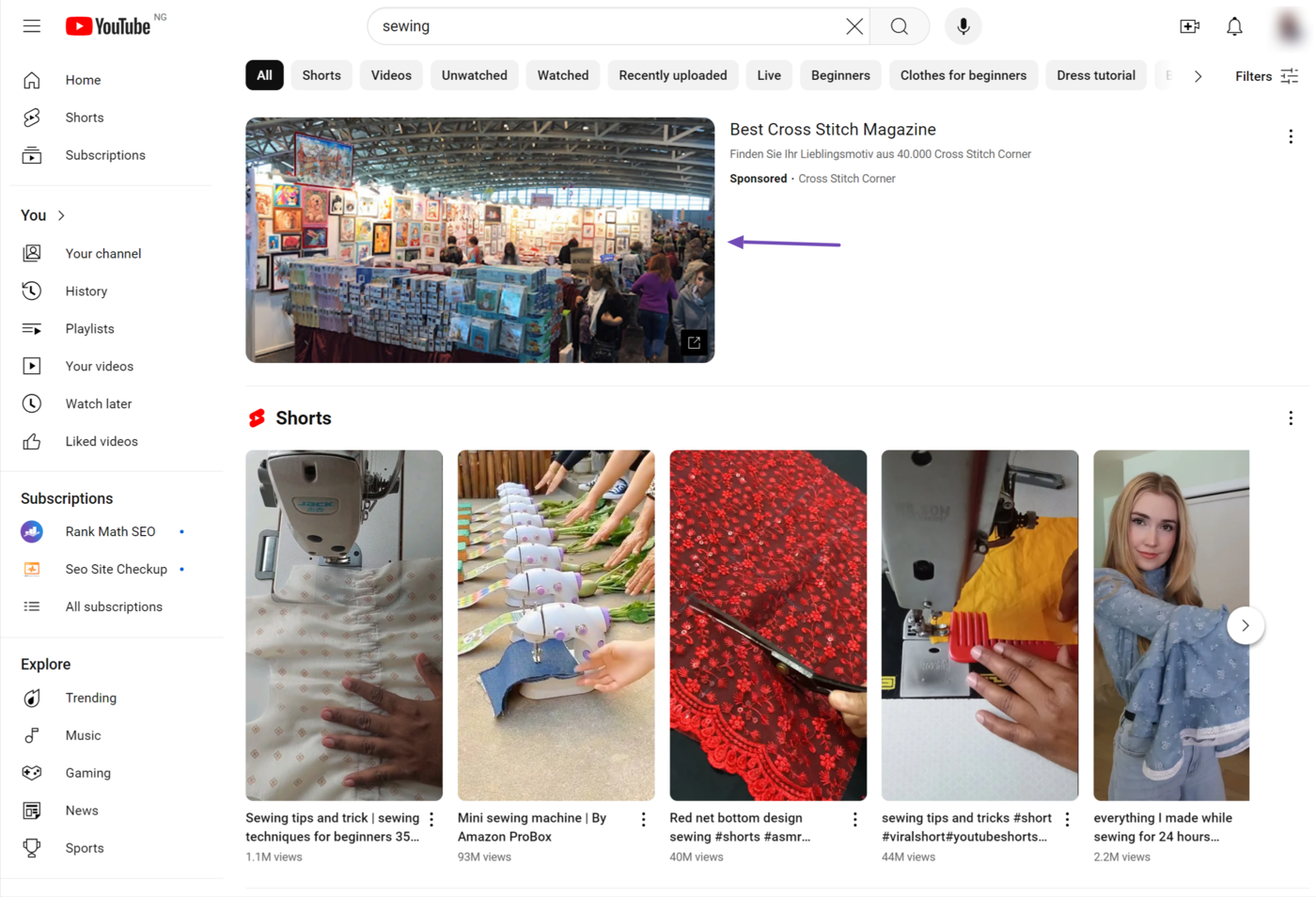
4 Shopping Ads
Shopping ads are a type of Google ad format that allows advertisers to promote their products directly on Google search results page, Shopping tab, and partner sites.
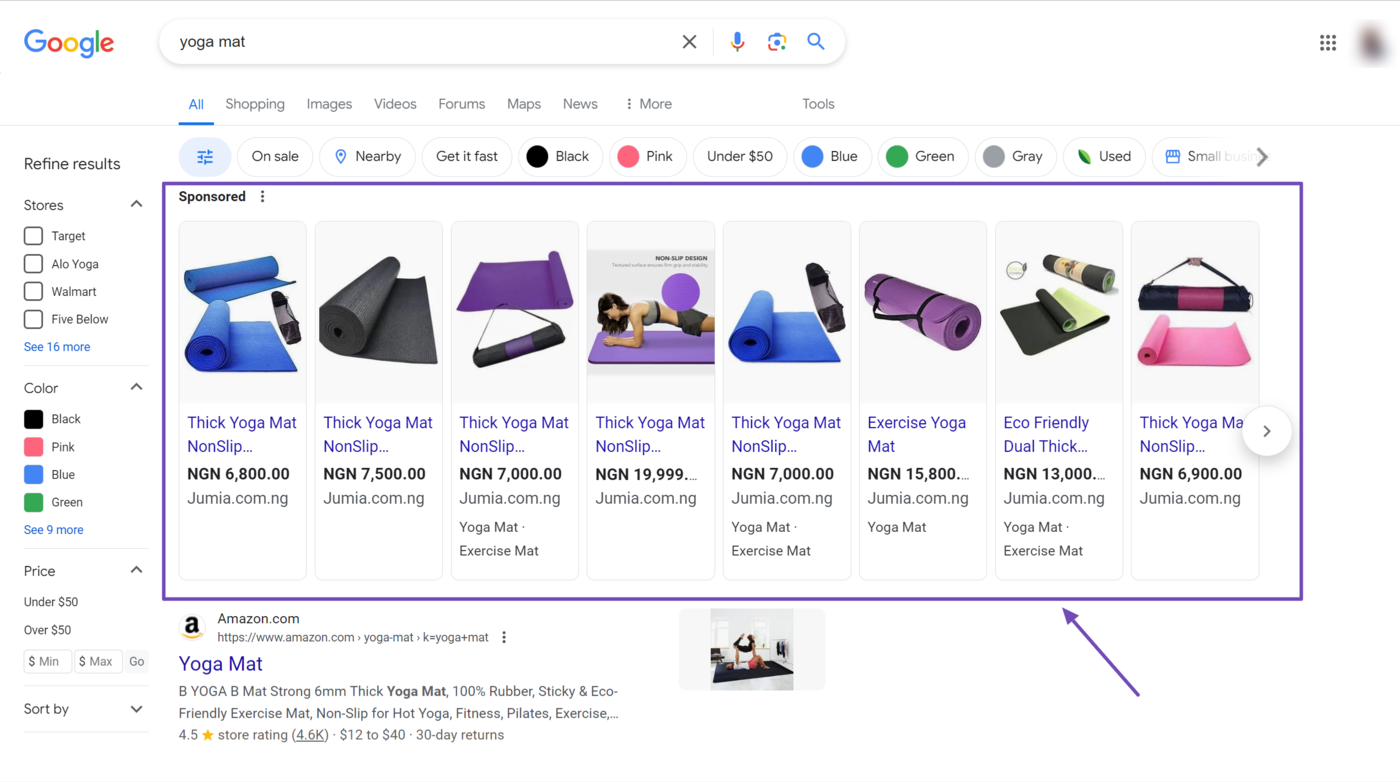
Shopping ads are typically used by e-commerce sites looking to drive sales and traffic to their online store. Advertisers looking to create shopping ads must set up and upload their product data to a Merchant Center account. Thereafter, they can proceed to create shopping ads.
5 App Ads
App promotion ads are a type of Google ad format that allows advertisers to promote their mobile apps across various Google platforms, including Search, Google Play, YouTube, and the Google Display Network.
App ads are designed to drive app installs and engagements by displaying relevant app information, such as the app name, icon, ratings, and a call-to-action button to download or install the app.
6 Discovery Ads
Discovery ads are a Google ad format that allows advertisers to reach potential customers as they browse content across Google platforms like YouTube, Gmail, and Discover.
The ads are displayed in Gmail’s promotions and social tab feeds, YouTube’s Home and Watch Next feeds, and the Google app’s Discover feed. Discovery ads can be carousel ads, image ads, or video ads.
7 Smart Ads
Smart ads allow advertisers to create simplified and automated ads. Advertisers only need to provide basic information about their business, and Google handles the rest, including optimizing the ads for maximum performance.
Smart ads are designed for small businesses with limited time and resources to manage their ads.
8 Performance Max Ads
Performance Max ads are a Google Ads format that allows advertisers to auto-generate multiple ad types displayed to target audiences across multiple Google networks and platforms.
Performance Max ads are a type of goal-based advertising wherein the advertiser provides Google with information about the goal of their campaign and then leaves Google to auto-generate appropriate ads to be displayed across Google’s platforms and services.